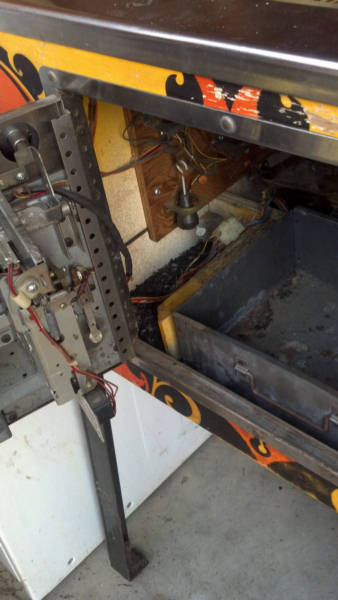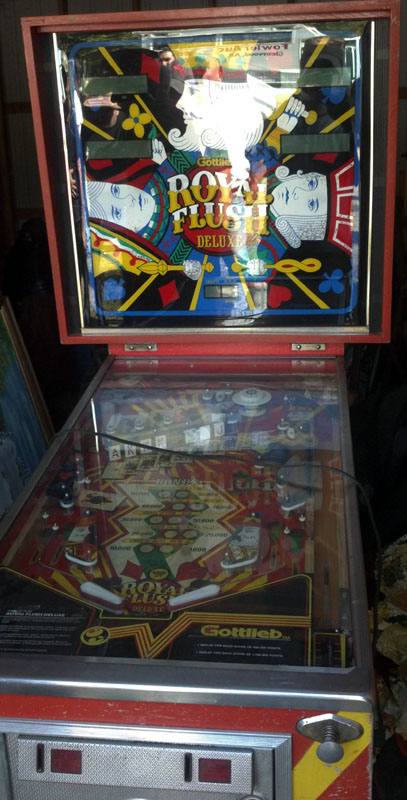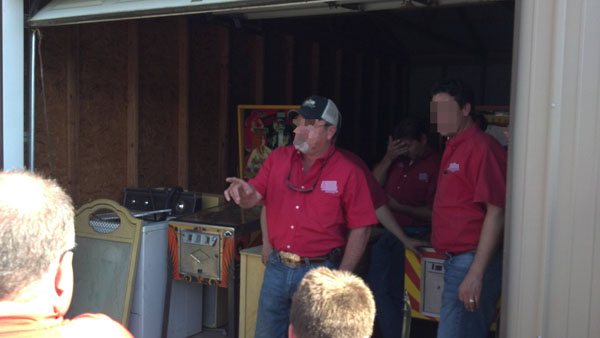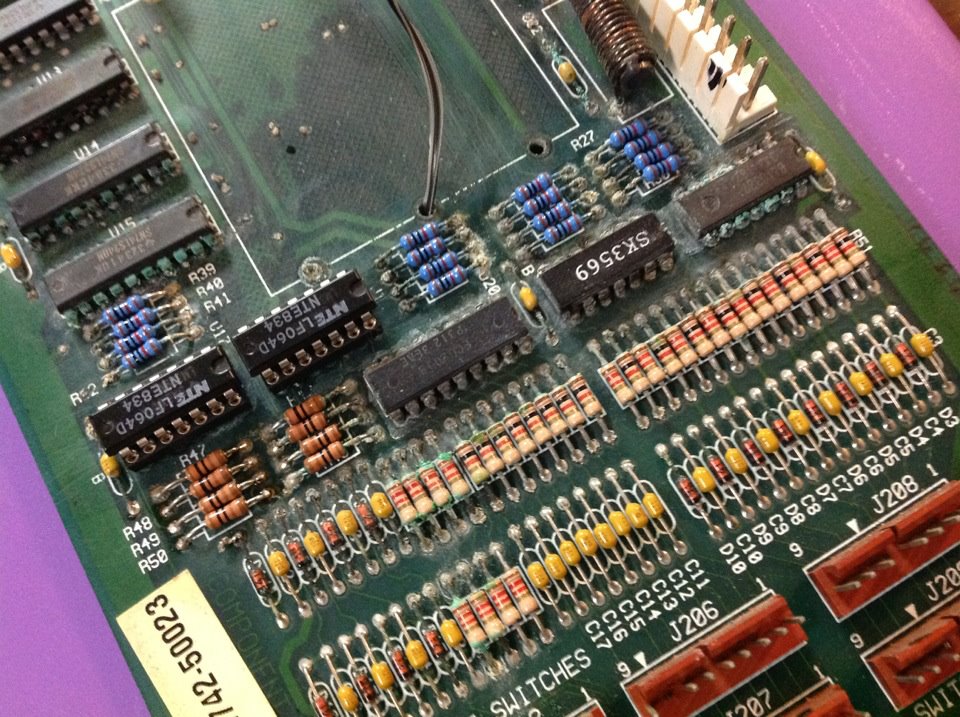
- 1977 Bally Mata Hari
Some people, you might say, talk too much. I’m probably one of them. Not necessarily in the literal sense, although I’m sure that’s a possibility too, but in the figurative sense, I probably reveal too much, too much information, more than was invited, and possibly more than is appreciated.
Margaretha Zelle probably could, in retrospect, say the same about herself. She talked too much, and especially at the wrong times, like during World War II when she was cavorting with military officers of different sides, and in an effort for more attention, revealed her interest. Ultimately she got more attention than she bargained for. The most famous so-called “spy” was executed as a result. In all likelihood, she probably wasn’t a spy; she just talked too much.
Another Mata Hari might as well have fared no better, being stuck in a storage shed in some otherwise nondescript backwoods town when along come the local auctioneers… This Mata Hari had been silent for a long, long time, but it talked to me…
Now, I really try not to be a cynical bastard. Sometimes it’s hard to not wake up in the morning and go, “Why bother?” and today might have been one of those days, so instead of cursing myself and all of mankind, I’m going to vent on this little blog and then be done with it.
So what am I talking about? Another pinball hunt of course. This one filled with intrigue, deception and misinformation. Our story starts as I get word of an auction not too far away featuring mostly firearms. Yea, one can never have too many firearms, but that’s not what I was after. In the ad was a picture of a pinball machine, a vintage Bally Mata Hari.
To give you an idea of the depth of my insanity, right now I’m looking at a beautiful Mata Hari game already in my possession, one that really doesn’t need much of anything – it still needs some work but there’s no major parts missing. Why would I care about another one? Well, it’s a pinball machine! I have to go see it. Even if I have one already.
Us pinball enthusiasts are also like anthropologists or zoologists. We can’t just see one homo-erectus skull. We need to see several of them and compare and make sure what we think is right, is right. So even if we have a pinball game, we are curious to see (and play) another game of the same title. Pinball games are like wine.. no two are completely identical. At least that’s my excuse. You buying it? Hey, I tried!
So anyway, this story starts as I go out to check this auction featuring a pinball machine. When I get there I find out there are actually two pinball machines at auction. Unfortunately they’re locked up and will be trotted out much later in the day after they get through with all the other stuff… so I hang out for 4+ hours letting my imagination run wild wondering if the other machine is some magically exotic game I’ve long been after. Hey, again, that’s my excuse!
So anyway, I finally manage to get someone’s attention and get them to uncrack the storage room and have me take a look at the pinballs before the auctioneer heads over. I was told they were going to bring a generator and plug the machines in to test them — that’s a no-no in my book. I don’t want crazy generator power going into an old machine adding insult to injury so I wanted a quick look before anyone else at just what we were dealing with.
As it turns out, the Mata Hari was in absolutely horrible condition. It’s not uncommon – this was a machine that saw a lot of play. But ironically, the backglass was almost perfect. I was hoping the backglass had the german writing on the dagger – there were two versions, and a later backglass version had the Nazi-esque writing removed from the dagger. That earlier backglass is more sought-after even though it’s not necessarily more rare.
Whenever I come across pins in storage, belonging to people who don’t know much about pinballs, my first concern is, “Do you have the keys?” Which of course they didn’t, and this means trying to transport the machines becomes increasingly more troublesome. It’s really, really bad to try to move a pinball with the head in the upright position. So immediately I’m realizing there’s as much a logistics problem packing up and moving the games, as there is determining if there is any type of deal to be made on the price. Strike one.

Mata Hari inside the coin door
I talk with the owner and he tells me he just bought the second machine; the first one, the Mata Hari (as always) he said, “Was completely working when I put it in storage..” Yea, right, famous last words. Every pinball game I’ve ever pulled out of a storage unit has had such glaring problems there is no way it was working when it was initially stowed. I think people believe that once something is put in storage it regenerates itself, kind of like the Borg. If only that were true.
On the Mata Hari coin door there is no key so I take a peek inside… looks like an entire army of rats has been living inside for years. There is literally 3″ inches of rat poop filling up the sides of the cabinet near the coin door. I can only imagine how bad it is in the back… and this doesn’t look like ancient rat poop either. Strike Two.
A look at the playfield of the Mata Hari reveals a wasteland of chipped plastics, severe playfield wear and broken rubbers and other MOOP (matter out of place). It’s obvious this game has not been played in years.
But I was really there to see what the “other” pinball machine was. The whole day, as I waited to catch a glimpse of the machines, I let my imagination run wild as to the unlikely potential that this would be a game I’d long sought after.

Gottlieb Royal Flush Deluxe
When the doors came up, it was a surprise: Gottlieb Royal Flush Deluxe. I had never even seen this game, but I instantly recognized the playfield as a copy of the vintage classic Card Whiz/Royal Flush, but this was a solid state version. At first I thought it was an old game that someone had created a different backglass for, but pulled out my phone to look it up on IPDB and sure-enough, it was a System80a copy. A bit over 2000 games were made – relatively low production. But this game too was ragged out, with broken plastics everywhere and playfield wear as well. The reviews on IPDB showed that it was considered inferior to the original.
So, neither game blows me away. I am intrigued by the Royal Flush Deluxe but in my mind, I have to get it at a song, and this machine too has the problem of being locked up with no keys, and no electricity in the place to plug in a drill, and the owner conveniently can’t produce a drill to crack the locks, and I wish I could pick locks, but I suck at it, and now I’m rambling….
So I’m thinking, there aren’t many people here, the games supposedly don’t have a reserve, I have a “magic number” in mind that I’d go for the games and go through the hassle of potentially catching bubonic plague if the price was right. Let’s see what happens.

Trust us. It works!
And what happens makes me angry.
The auctioneers roll up and announce that they just played these machines and they both work, and then immediately begin to start the auction. I’m like, “Are you kidding me?” Bam, before I can pick my jaw up, the Mata Hari goes for close to $400. WTF? And then the Royal Flush Deluxe goes for about $350. Someone blew more than $700 + a 10% buyers premium on those POS.
Now I understand about caveat emptor, but to see an auctioneer stand there and lie was bold. I know also in the industry this probably isn’t unheard of either, but it just goes to show that there are tons of pitfalls in the business of obtaining and restoring pinball games. It’s not just about finding what’s wrong and getting the parts. Sometimes getting the machine itself can be its own trial. I tagged along after the gentleman who ended up getting both machines. He was a nice-enough guy whom I found out had no idea how to repair machines, and assumed those guys were honest in saying “they work!” I felt sorry for him and gave him my number, but I also kind of felt bad for myself because I probably didn’t have the time to help him knowing the level of help the machines needed. Especially the Mata Hari – that’s one game I don’t know if I would have restored. So I talked too much and revealed to him that I was skeptical that Mata Hari would be something that was going to work when he plugged it in. Good luck with that.






